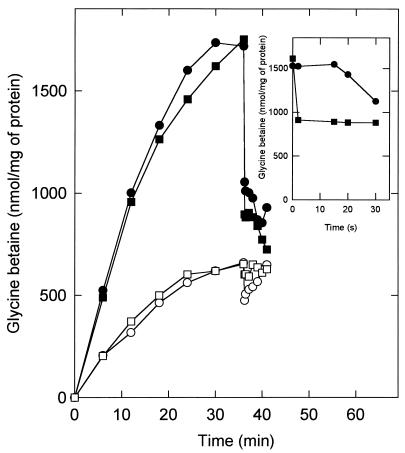FIG. 4.
Hypo-osmotic shock and chlorpromazine trigger efflux of [14C]glycine betaine. Cells of L. plantarum ATCC 14917 were grown on CDM containing 0.8 M KCl, washed, and resuspended in 50 mM potassium phosphate (pH 6.5). The concentrated cell suspensions were diluted in 50 mM potassium phosphate (pH 6.5) to a final protein concentration of 0.39 mg/ml. After 6 min of preenergization with 10 mM glucose, uptake was initiated at time zero by the addition of [14C]glycine betaine (final concentration of 1.3 mM) without (open symbols) or with (closed symbols) 0.8 M KCl (final concentration). After 36.5 min, 0.1 mM chlorpromazine (final concentration) was added (circles), or the samples were diluted fivefold with 50 mM potassium phosphate (pH 6.5) containing 10 mM glucose plus 1.3 mM [14C]glycine betaine (squares). The inset shows the lag time of the efflux triggered by the addition of 0.1 mM chlorpromazine (circles); the efflux after hypo-osmotic shock (squares) is instantaneous, since 2 s is the time resolution of the experiment.

